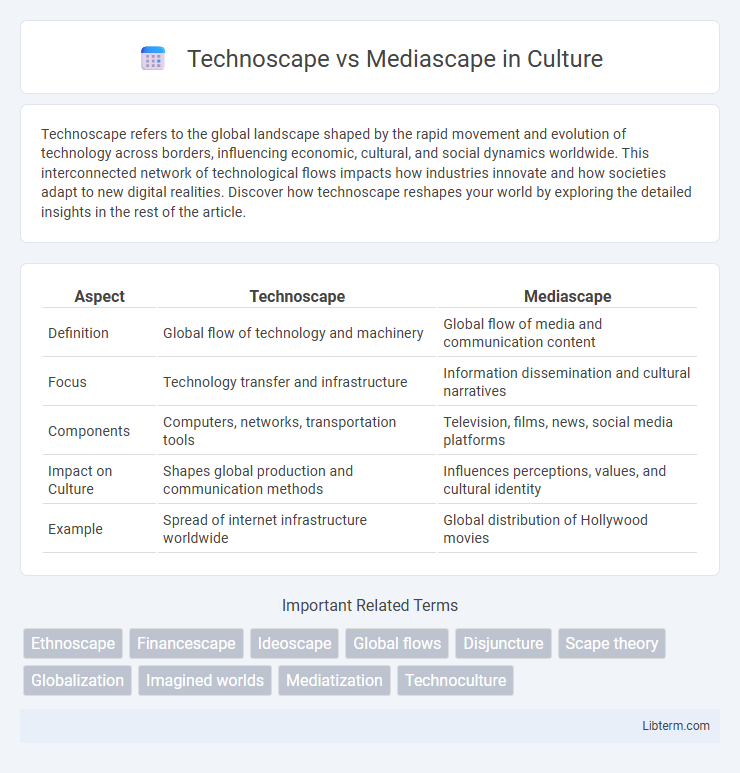Technoscape refers to the global landscape shaped by the rapid movement and evolution of technology across borders, influencing economic, cultural, and social dynamics worldwide. This interconnected network of technological flows impacts how industries innovate and how societies adapt to new digital realities. Discover how technoscape reshapes your world by exploring the detailed insights in the rest of the article.
Table of Comparison
| Aspect | Technoscape | Mediascape |
|---|---|---|
| Definition | Global flow of technology and machinery | Global flow of media and communication content |
| Focus | Technology transfer and infrastructure | Information dissemination and cultural narratives |
| Components | Computers, networks, transportation tools | Television, films, news, social media platforms |
| Impact on Culture | Shapes global production and communication methods | Influences perceptions, values, and cultural identity |
| Example | Spread of internet infrastructure worldwide | Global distribution of Hollywood movies |
Introduction to Technoscape and Mediascape
Technoscape refers to the global flow and distribution of technology across countries and regions, encompassing digital infrastructure, IT networks, and technological innovations that shape economic and social landscapes. Mediascape involves the distribution and accessibility of media content worldwide, including television, film, news, and digital communication channels that influence cultural perceptions and information dissemination. Both technoscape and mediascape interact to transform global connectivity, with technoscape providing the technological platforms that enable mediascape's widespread media flows.
Defining Technoscape: The Flow of Technology
Technoscape refers to the global configuration and rapid flow of technology across borders, encompassing hardware, software, and technical expertise that shape contemporary societies. It highlights the dynamic movement and diffusion of innovations, digital infrastructure, and technological resources, influencing economic development and cultural interactions worldwide. This flow challenges traditional boundaries by enabling instantaneous exchanges of information and tools, transforming production processes and communication patterns globally.
Understanding Mediascape: The Realm of Information
Mediascape encompasses the global flow of information through mediums like television, newspapers, and digital platforms, shaping perceptions and cultural narratives across societies. It plays a critical role in influencing public opinion, disseminating news, and constructing social realities in the digital age. Understanding mediascape involves analyzing how media content circulates and impacts identity, politics, and societal structures worldwide.
Historical Evolution of Technoscape and Mediascape
Technoscape has evolved through successive waves of technological innovation, from the Industrial Revolution's mechanical advances to today's digital and networked infrastructures, profoundly reshaping global communication and production landscapes. Mediascape developed alongside the rise of mass media, transitioning from print and radio to television and now to digital platforms, reflecting shifts in cultural narratives and information dissemination practices across societies. The historical evolution of both technoscapes and mediascapes illustrates intertwined patterns of technological progress and media expansion that have collectively transformed socioeconomic dynamics and global connectivity.
Key Differences Between Technoscape and Mediascape
Technoscape refers to the global configuration and movement of technology, including hardware, software, and information systems, while mediascape emphasizes the flow and distribution of media content, images, and narratives across cultural and social platforms. Technoscape shapes the infrastructure and technological capabilities underpinning global communication, whereas mediascape influences the perception, interpretation, and consumption of media in diverse societies. The key difference lies in technoscape's focus on technological networks and material flows, contrasting with mediascape's emphasis on the symbolic and representational aspects of media dissemination.
Intersections and Interdependencies
Technoscape and Mediascape intersect through the integration of digital technologies in media production, distribution, and consumption, highlighting their interdependence in shaping global communication flows. Technoscape's infrastructure enables rapid content creation and dissemination across Mediascape platforms, facilitating real-time interaction and cultural exchange. The symbiotic relationship between technological networks and media landscapes drives innovation, influencing social dynamics and geopolitical narratives worldwide.
Impact on Globalization and Cultural Exchange
Technoscape, referring to the global configuration of technology and its rapid dissemination, accelerates globalization by enabling real-time communication and cross-border digital innovation, thus shrinking geographical barriers. Mediascape involves the distribution of information and cultural narratives through global media networks, shaping perceptions and cultural identities across nations. Together, Technoscape and Mediascape drive cultural exchange by facilitating the spread of technology and media content, fostering interconnectedness while simultaneously challenging traditional cultural boundaries.
Challenges and Ethical Considerations
Technoscape and Mediascape present distinct challenges and ethical considerations related to technology and information flow. Technoscape involves the global movement of technology and expertise, raising concerns about digital divide, data privacy, and the environmental impact of electronic waste. Mediascape focuses on the dissemination of information through media, highlighting issues of misinformation, cultural homogenization, and the ethical responsibility of content creators in shaping public perception.
Contemporary Examples and Case Studies
Technoscape refers to the global configuration of technology and electronic infrastructure shaping communication, evident in the rise of 5G networks enabling real-time data transfer across continents. Mediascape encompasses the distribution of media content and narratives, illustrated by streaming platforms like Netflix influencing cultural perceptions worldwide. Contemporary case studies such as China's integration of AI in smart city projects (technoscape) and the global spread of K-pop through digital media channels (mediascape) highlight the interplay of technological frameworks with media dissemination in shaping global culture.
Future Trends of Technoscape and Mediascape
Future trends in technoscape highlight advancements in AI-driven automation, IoT integration, and immersive technologies like AR and VR transforming global communication and productivity landscapes. Mediascape's evolution emphasizes personalized content delivery through AI algorithms, increased use of interactive platforms, and the expansion of decentralized media via blockchain for enhanced transparency and user control. Both technoscape and mediascape are converging towards fostering hyperconnected environments that prioritize real-time data exchange and user-centric experiences.
Technoscape Infographic

 libterm.com
libterm.com